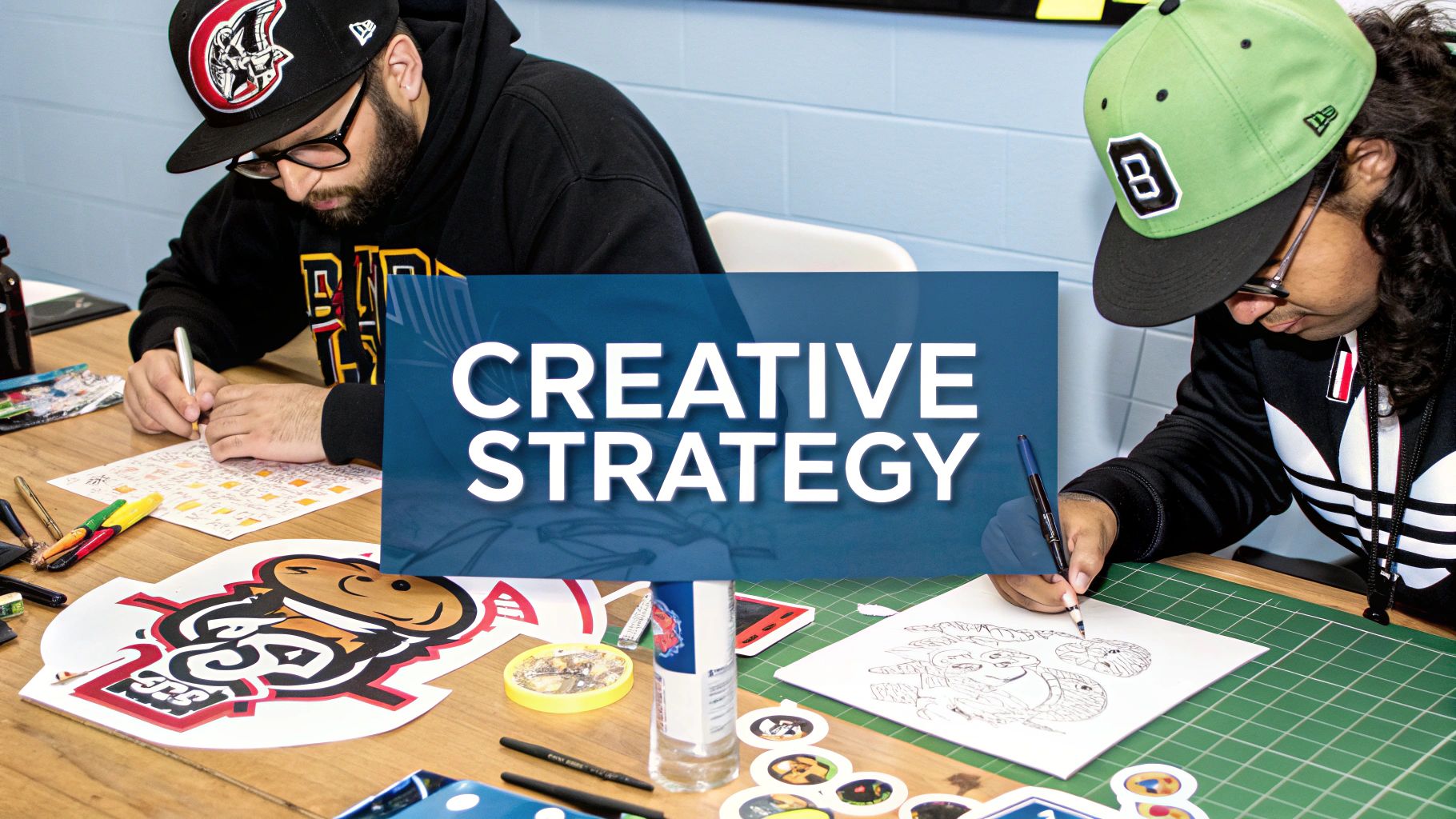
Understanding the Power of Brand Storytelling

Consumers encounter countless marketing messages every day. To stand out and build real connections, brands need to move beyond traditional advertising toward brand storytelling. Rather than just highlighting features and benefits, effective storytelling creates emotional connections that resonate with audiences on a deeper level.
Why Stories Matter
Stories tap into our basic human need for connection and meaning. Think about your favorite movie – it likely stirs emotions and stays with you long after watching. The same applies to brands. When done well, brand stories turn routine purchases into memorable moments that build lasting loyalty. It's similar to how an engaging novel captivates you versus reading a technical manual – both share information, but stories create stronger, more meaningful impressions.
Consider a sustainable fashion brand. Instead of only promoting eco-friendly materials, they could share the personal stories of their skilled artisans and their dedication to ethical practices. This helps customers connect with the real people and values behind the brand, setting it apart from competitors selling similar products.
The Impact of Narrative on Consumer Behavior
Research shows that 92% of consumers prefer advertisements that tell stories. This isn't just a trend – it reflects people's desire for authentic emotional connections with the brands they choose. Learn more about measuring storytelling success. When people connect with a brand's story, they aren't just buying products – they're buying into shared values and meaning.
Building a Brand Storytelling Framework
Creating effective brand stories requires more than just telling interesting tales. You need a clear strategy that includes understanding your audience, defining your core values, and developing compelling narratives. Your stories should feel genuine and relatable while maintaining consistency across all channels. With a solid storytelling framework, you can create lasting connections with customers who align with your brand's mission and values.
Core Elements of an Effective Brand Storytelling Framework
A great brand story creates deep emotional connections with customers. It elevates products beyond features into meaningful experiences that customers want to be part of. Building this type of story requires a clear brand storytelling framework – a strategic approach that aligns your brand identity with what matters most to your audience.
Defining Your Brand's Narrative Identity
Start by finding your brand's authentic voice. What sets you apart? What fundamental beliefs drive your brand forward? This voice needs to stay consistent everywhere – from social posts to product pages. Your core values serve as guideposts for every decision and action. These principles attract customers who believe what you believe. Create key messaging themes that support your main story. These themes provide the foundation for clear, consistent communication across all channels.
Structuring Your Story for Emotional Impact
Map out clear character types that reflect your customers. What do they hope for? What challenges do they face? Understanding their deeper motivations helps you tell stories that truly connect. Build dramatic tension into your narrative arc. Like any good story, your brand's journey should have rising action, a key turning point, and a satisfying resolution. For instance, a fitness brand might highlight the real struggles of getting healthy before showing how their products helped overcome those challenges.
Want to take your content strategy further? Check out this guide on How to master content strategy.
Weaving Narrative Elements for Cohesive Storytelling
Stories shape how people value things. The Significant Objects Project proved this beautifully. They took cheap thrift store items worth less than $1.50, added fictional stories, and resold them on eBay. The result? Those items sold for $3,612.51 total – a 2,700% return. Learn more about the ROI of storytelling. This shows how strong stories boost perceived value and engagement. Weave your values, key messages and customer focus into every interaction point. This creates a seamless brand experience that builds lasting emotional bonds. A clear framework keeps your story consistent and impactful across all touchpoints.
Building Authentic Connections Through Story

Creating meaningful brand stories requires genuine authenticity. When you share real stories that reflect your true values and mission, you build lasting emotional bonds with your audience. Rather than relying on marketing jargon, successful brand storytelling digs deep into what makes your company unique and special.
Incorporating Authentic Voices
Real stories from real people make your brand more relatable and trustworthy. Customer reviews and testimonials provide social proof and credibility. Employee stories showcase the human side of your business by highlighting the passionate people behind your brand. These authentic perspectives create deeper connections with audiences seeking genuine relationships with the brands they support.
Balancing Transparency and Compelling Narratives
Today's consumers easily spot fake or overly polished brand messages. While you don't need to share every detail, being open about your values, purpose and even challenges builds trust. The key is ensuring your actions match your words across every customer touchpoint – from service interactions to product development. When you consistently deliver on your brand promises, you create meaningful stories that resonate.
The Power of Emotional Connection
Research shows that authentic storytelling directly impacts purchasing decisions. 86% of consumers say authenticity influences their brand choices, while 64% specifically seek emotional connections with brands they buy from. Learn more about these statistics. This data confirms that when brands tell genuine stories that strike an emotional chord, they're more likely to win long-term customer loyalty. By focusing on authentic narratives that reflect your true identity, you can build deeper relationships with your audience and stand out in meaningful ways.
Crafting Your Brand's Story Arc
A great brand story needs both honesty and structure. The right brand storytelling framework helps transform basic facts about your company into an engaging narrative that connects with your audience.
Adapting Classic Narrative Frameworks
Traditional story structures work incredibly well for modern brands. Take the hero's journey – it maps perfectly to how customers interact with products. Your customer starts with a problem (the challenge), discovers your solution (the transformation), and achieves their goal (the return). This positions your brand as a helpful guide rather than the hero – you're there to support customers on their path to success.
Identifying Key Moments and Characters
Strong stories are built around memorable moments and clear characters. For your brand, highlight defining events like your origin story, major milestones, or times you overcame obstacles. Make your customer the main character, with your brand playing a supporting role. This approach helps people see themselves in your story and builds genuine connections.
Creating Interest Through Conflict
Stories need tension to keep people engaged. Show how your brand helps solve real customer problems – this creates natural drama that pulls people in. Match your story's emotional tone to where customers are in their journey. For example, a productivity app might first empathize with the stress of being disorganized, then celebrate the relief of getting organized.
Frameworks for Different Audiences
Your story needs to flex for different groups – new customers want different things than loyal fans. Build storytelling templates that maintain your core message while adjusting the details for each audience. This could mean creating versions for social media that focus on quick wins, while using email to share deeper customer success stories. The key is keeping your main narrative consistent while tailoring how you tell it.
Implementing Your Brand Story Across Channels

Your brand story needs to reach your audience wherever they are. Think of it like a great song – the melody stays recognizable whether played on piano, guitar, or with a full orchestra. The key is keeping your core message consistent while adjusting how you tell it across different platforms.
Adapting Your Narrative for Different Platforms
Each platform has its own sweet spot. Instagram shines with visual stories, while Twitter works best for quick, punchy messages. Your story should flex to fit each space while keeping its heart intact. For example, you could turn a detailed blog post about your eco-friendly practices into a series of behind-the-scenes Instagram stories showing your team in action.
Maintaining Consistency Across Touchpoints
Building trust means staying consistent everywhere customers find you. Create clear guidelines for your brand's voice, tone, and visuals to keep everyone aligned. A solid style guide gives your team a north star to follow. Want to dig deeper? Check out How to master a small business marketing strategy.
Training Your Team to Be Brand Storytellers
Every team member should know your story by heart. When they do, they become natural ambassadors who share your message authentically in every customer interaction. Consider running storytelling workshops or making it part of new hire training. Your support team could weave in real examples when helping customers, making each interaction more meaningful.
Adapting to Emerging Platforms
New ways to connect with audiences pop up all the time. Your story framework should bend without breaking as you try new platforms. Maybe that means testing short videos or interactive content. The trick is staying open to fresh formats while keeping your core message strong. This helps your brand stay relevant as communication channels change.
Measuring Brand Storytelling Success

Creating great brand stories is only half the battle. To truly understand if your storytelling efforts work, you need to measure both their emotional impact and business results. Like movie directors analyzing ticket sales and reviews, smart brands track key metrics to see how their stories perform.
Quantitative Metrics: Tracking the Tangible
The numbers tell an important part of the story. Website traffic to your story content shows if people are interested. Social media engagement – shares, likes, and comments – reveals how well stories connect and spread naturally. Lead generation shows if stories attract potential customers. Most importantly, sales conversions demonstrate whether stories drive purchases. These concrete metrics paint a clear picture of business impact.
Qualitative Metrics: Understanding the Emotional Impact
Raw numbers don't capture everything. You also need to understand how people feel about and connect with your stories. Customer surveys and feedback forms provide direct input on what works and what doesn't. Social listening – tracking online conversations about your brand – uncovers real sentiment and perceptions. This emotional data adds crucial context to the numbers, showing how feelings drive actions. You might be interested in: How to master proven business networking strategies.
Building a Storytelling Dashboard: Visualizing Your Success
Make tracking simple with a storytelling dashboard. This central hub should display your key metrics clearly – website stats, social engagement, and sales tied to specific stories. The dashboard helps spot trends, find areas to improve, and show stakeholders the real value of your storytelling. Regular monitoring lets you fine-tune stories for better results.
Ready to build your own thriving business? Visit Jason Yormark for expert guidance on entrepreneurship, marketing, and building a successful agency.


Leave a Reply